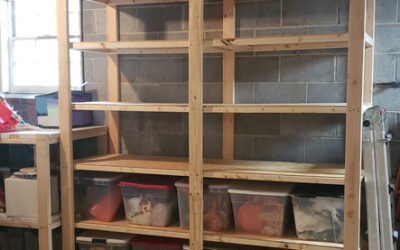Self-storage offers individuals and businesses secure off-site spaces to keep their belongings. Units are rented on a month-to-month basis for a fee.
So, how much does it cost to rent a self-storage unit? Keep reading to learn about the latest self-storage pricing trends.
Average Self-Storage Unit Cost
The current average price to rent a self-storage unit in the United States is $85.14 a month, as of March 2024.
That price includes all unit sizes and types. You might pay more or less for a storage unit depending on the unit size, your geographic location, and any amenities such as climate control. Depending on their location, self-storage tenants can expect to pay between $30 a month for a small 5×5 unit, and up to $250 or more for a larger 10×20 or 10×15 unit.
Current Self-Storage Pricing Trends
Currently nationwide, self-storage prices are on a downward trend as COVID-19 demand has gone away and new home sales remain in limbo. Average storage prices are down 13.6% compared to the same month last year.
Average Self-Storage Rental Cost by Unit Size in 2024
One of the biggest determinants of self-storage pricing is size.
Usually larger units are more expensive to rent than smaller units, but cost less on a per square foot basis. Local demand and availability for certain sizes in a market or at a single facility can also affect the price.
The table below shows the year-to-date average rental cost in 2024 through March for the five most popular storage unit sizes. Average prices are calculated using data for storage units rented through SpareFoot.com:
| Unit size | Avg. Monthly Storage Prices (2024) | $/sq.ft. | Share of all units |
|---|---|---|---|
| 5×5 | $37.65 | $1.51 | 17% |
| 5×10 | $56.61 | $1.06 | 23% |
| 10×10 | $89.46 | $0.89 | 20.4% |
| 10×15 | $119.17 | $0.79 | 9.9% |
| 10×20 | $139.11 | $0.68 | 6.8% |
Average Self-Storage Rental Costs by State in 2024
If you are searching for "storage units near me", prices will vary widely depending on where you live in the United States.
This is due to the square foot of self-storage per capita available in your market. The less square footage of self-storage space available per capita, the higher prices you can expect to find. Generally this means, you can expect to pay more in dense urban areas where demand is higher and developing self-storage is more costly. Prices can vary widely within cities though, as most facilities draw from customers within a 1 to 3 mile radius.
To get an idea of self-storage rates near you, check the recent average price for your state using the chart below.
| State | Average Price | State | Average Price | State | Average Price | State | Average Price |
|---|---|---|---|---|---|---|---|
| All | $85.14 | OR | $87.37 | NC | $78.08 | OH | $69.81 |
| HI | $136.14 | ME | $87.16 | IL | $77.83 | AL | $68.54 |
| CA | $110.80 | CO | $86.65 | MS | $75.78 | KY | $68.50 |
| NY | $100.50 | ND | $86.18 | VT | $75.61 | LA | $67.88 |
| WA | $99.35 | SD | $83.88 | KS | $75.57 | NE | $67.64 |
| CT | $98.54 | NV | $83.83 | MN | $75.49 | NM | $64.35 |
| NJ | $93.10 | MI | $83.32 | MT | $74.08 | IA | $63.80 |
| MD | $92.82 | PA | $82.88 | MO | $73.32 | WY | $62.75 |
| FL | $91.51 | WV | $81.89 | TN | $73.32 | OK | $62.66 |
| DE | $91.11 | ID | $81.49 | TX | $73.31 | IN | $62.18 |
| MA | $90.67 | RI | $80.76 | AZ | $72.74 | DC | $60.96 |
| UT | $90.07 | NH | $80.30 | WI | $72.34 | AR | $60.63 |
| VA | $88.90 | GA | $78.57 | SC | $71.02 |
Other Factors Affecting the Cost of Self-Storage
Aside from unit size and location, there are a few other factors that directly impact the price paid for a self-storage unit.
- Time of year. Demand for self-storage units fluctuates during the course of the year. Prices typically climb in the spring and peak by the end of summer.
- Climate-control. Climate-controlled storage units are generally about 30 to 50 percent more expensive than units without climate control.
- Unit availability. Having a limited number of popular units available at a facility might cause their price to go up. Conversely, having a large number of units available of the same size might prompt a discount on that unit type.
- Unit location. Self-storage units located on the ground level or near an elevator might cost more than the same-size unit elsewhere at the same facility.
- Rent increases. Self-storage leases are month-to-month contracts, and it is not uncommon for self-storage operators to increase rents after every six to 18 months. Increases are typically 5% to 10%
- Other amenities. Other amenities such as 24-hour access, electricity in unit, individual door alarms, and additional security features will add to the overall cost of a self-storage unit.
Storage Unit Insurance Coverage Cost
It is important to remember that insurance is not included with the price of storage, most storage facilities require proof of insurance. Oftentimes your homeowners or renters policy will cover your items in storage, but not always. You can purchase specific coverage for your storage items from the facility you are renting from.
Generally speaking, $2,000 of coverage will cost around $10 to $12 a month. Policies can go up to around $30 a month and provide up to $5,000 worth of insurance coverage.
Tips For Reducing the Rental Cost of Self-Storage
Promotions and specials are very common in the storage industry, so it pays to shop around.
Some companies offer first month free deals or reduced rent for the first few months, for example. When shopping for a storage unit, these promos should be factored into the overall price of a storage unit. Be sure to read the fine print, however, to see if there is a minimum commitment required.
Facilities often offer discounts to groups such as seniors, teachers, students and veterans. These special prices aren't always advertised, so make sure to ask before signing your rental agreement.
Here are some more ways for keeping your monthly self-storage bill in check:
- Shop around and use comparison sites to find the best price and location for your needs.
- If you aren’t storing sensitive items, consider skipping a climate-controlled unit and opt for a traditional unit without it.
- You will pay the highest prices between May and September, If you want the lowest prices, consider timing your storage rental between November and March.
- Ask if there is a cash discount or an Auto-Pay discount available.
- Negotiate any rent increases if you don’t think they are reasonable. Sometimes operators must raise prices to keep up with the rest of the market, however there may be some wiggle room for reliable customers who object.
The national average monthly cost to rent a storage unit is $85.14 This average includes all sizes and both climate controlled and non-climate controlled units. A 5x5 storage unit on average costs about $37.65 per month. This price includes both climate controlled and non-climate controlled units. The average cost for a 10x10 storage unit is $89.46 per month. A 10x10 storage unit is also the most popular size among renters. A 10x15 storage unit costs on average $119.17 per month, and is considered a large unit since it can hold the entire contents of a one-bedroom house. The national average cost of a 10x20 storage unit is $139.11 a month. A 10x20 unit is considered a very large storage unit, and is generally less commonly booked. A 5x5 and 5x10 unit are considered small storage units and have an average monthly cost between $35 and $60. Large storage units include 10x15, 10x20, and 10x30 and have an average monthly cost starting between $120 and $140. Larger units are growing in popularity due to increased sales of boats and RVs.Frequently Asked Questions (FAQs) on Storage Prices
How much does a storage unit cost?
How much does a 5x5 storage unit cost?
How much does a 10x10 storage unit cost?
How much is a 10x15 storage unit?
How much does a 10x20 storage unit cost?
How much is a small storage unit?
How much is a large storage unit?


